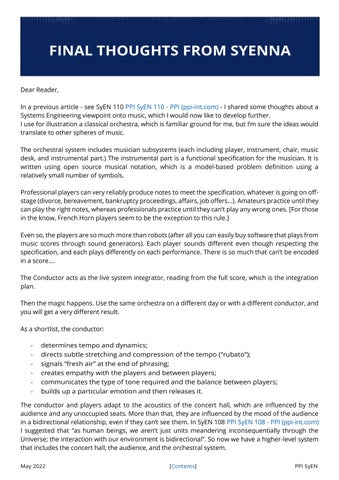FINAL THOUGHTS FROM SYENNA
FINAL THOUGHTS FROM SYENNA
Dear Reader, In a previous article - see SyEN 110 PPI SyEN 110 - PPI (ppi-int.com) - I shared some thoughts about a Systems Engineering viewpoint onto music, which I would now like to develop further. I use for illustration a classical orchestra, which is familiar ground for me, but I’m sure the ideas would translate to other spheres of music. The orchestral system includes musician subsystems (each including player, instrument, chair, music desk, and instrumental part.) The instrumental part is a functional specification for the musician. It is written using open source musical notation, which is a model-based problem definition using a relatively small number of symbols. Professional players can very reliably produce notes to meet the specification, whatever is going on offstage (divorce, bereavement, bankruptcy proceedings, affairs, job offers…). Amateurs practice until they can play the right notes, whereas professionals practice until they can’t play any wrong ones. [For those in the know, French Horn players seem to be the exception to this rule.] Even so, the players are so much more than robots (after all you can easily buy software that plays from music scores through sound generators). Each player sounds different even though respecting the specification, and each plays differently on each performance. There is so much that can’t be encoded in a score…. The Conductor acts as the live system integrator, reading from the full score, which is the integration plan. Then the magic happens. Use the same orchestra on a different day or with a different conductor, and you will get a very different result. As a shortlist, the conductor: -
determines tempo and dynamics; directs subtle stretching and compression of the tempo (“rubato”); signals “fresh air” at the end of phrasing; creates empathy with the players and between players; communicates the type of tone required and the balance between players; builds up a particular emotion and then releases it.
The conductor and players adapt to the acoustics of the concert hall, which are influenced by the audience and any unoccupied seats. More than that, they are influenced by the mood of the audience in a bidirectional relationship, even if they can’t see them. In SyEN 108 PPI SyEN 108 - PPI (ppi-int.com) I suggested that “as human beings, we aren’t just units meandering inconsequentially through the Universe; the interaction with our environment is bidirectional”. So now we have a higher-level system that includes the concert hall, the audience, and the orchestral system. May 2022
[Contents]
PPI SyEN
